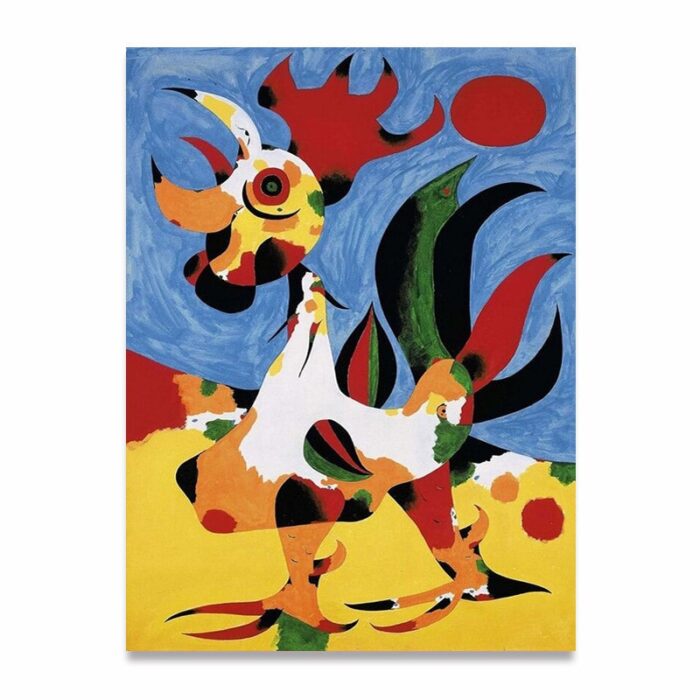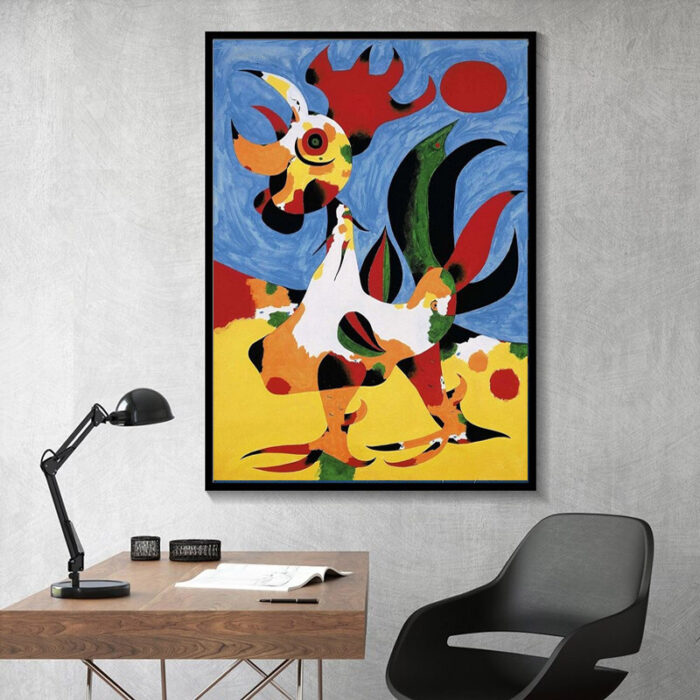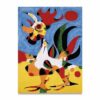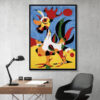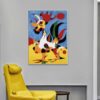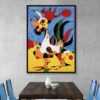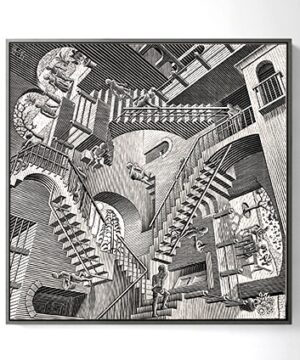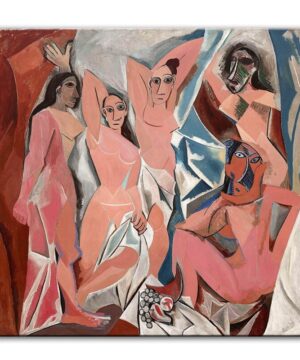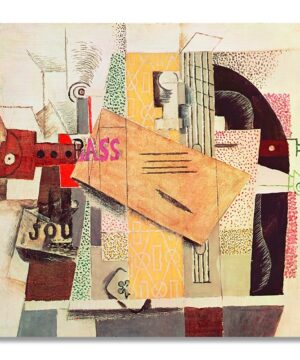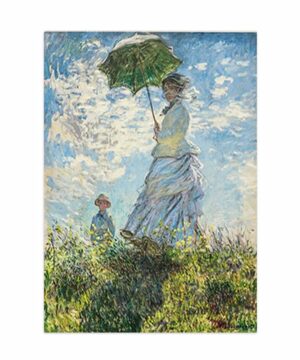Where is the picture “Le Coq” today?
The original of “Le Coq” by Joan Miró was sold at the auction house Christie’s London in 2007 and is currently part of a private collection.What’s in it?
In Le Coq, Joan MiróSpanish Catalan artist Joan Miró (1893 – 1983) is famous for his works in painting, sculpture, and ceramics. His work is strongly influenced by his hometown Barcelona, the scenic seaside, and the distinct style of that area. From early on, he was exposed to the arts through his parents’ professions: His mother was a goldsmith, father worked as a watchmaker. More uses a limited, but intense palette of colours to depict a rooster in front of a landscape, using gouacheGouache is a painting medium similar to watercolor but with a higher pigment content, resulting in a more opaque and vibrant finish. Known for its versatility and rich texture, gouache is favored by artists for its ability to create both detailed illustrations and bold, expressive works. Historical Background Gouache has a long history, used by artists and illustrators across various More and watercolour in combination with pencil drawingDrawing is a foundational art form that involves creating images on a surface, typically paper, using tools such as pencils, pens, and charcoal. It is a versatile medium that allows artists to express ideas, emotions, and stories through lines, shapes, and shading. Historical Background • Prehistoric Beginnings: The earliest known drawings date back to prehistoric times, with cave drawings found More. The rooster completely dominates the composition, his head tilted backwards, and his sharp beak opened as if giving a defiant scream. This piercing notion is emphasized by the contrast of colours. Searing reds vibrate alongside grass green. The saturated yellow earth hits the azure blue sky – which is more evocative of Mont-Roig, where Miró’s family had a summer house than of the Normandy coast. Interspersed black elements emphasize the sharpness of the beak and the claws, heighten the variegation of the white plumage, and push the contrasts to a new level.What’s the context?
Joan MiróSpanish Catalan artist Joan Miró (1893 – 1983) is famous for his works in painting, sculpture, and ceramics. His work is strongly influenced by his hometown Barcelona, the scenic seaside, and the distinct style of that area. From early on, he was exposed to the arts through his parents’ professions: His mother was a goldsmith, father worked as a watchmaker. More neither positioned himself as an explicitly political artist nor did he work exclusively formalistically with pure colours and forms, turning a blind eye to developments in society. He considered himself a man of freedom and liberalism. However, the movement for Catalan independence, the Civil War, the Franco dictatorship, as well as the Second World War strongly influenced his work. Joan Miró’s “Le Coq” was painted in a village on the Normandy coast called Varengeville-sur-Mer, where he and his family sought refuge from 1939 to 1940 at the beginning of the Second World War. The artist commented: “At Varengeville-sur-Mer, in 1939, began a new stage in my work which had its sources in music and nature. It was about the time that the war broke out. I felt a deep desire to escape. I closed myself within myself purposely.”Chatter and Prattle
Joan MiróSpanish Catalan artist Joan Miró (1893 – 1983) is famous for his works in painting, sculpture, and ceramics. His work is strongly influenced by his hometown Barcelona, the scenic seaside, and the distinct style of that area. From early on, he was exposed to the arts through his parents’ professions: His mother was a goldsmith, father worked as a watchmaker. More, “Le Coq” – Facts:- Miró’s instinct for political engagement was heartfelt, full of fear of risk and danger. He would often react through gestures of withdrawal and self-defence. André BretonAndré Breton (1896 – 1966) was a French writer and poet, best known as an original member of the Dada group and one of the founders of the Surrealism movement. His seminal writings include the first Surrealist Manifesto (Manifeste du surréalisme), published 1924, in which he defined surrealism as "pure psychic automatism", encouraging chance and spontaneity in artistic practices. Breton More, the founder of the surrealist movement, once referred to Miró, as a case of “arrested development” and as a childlike artist – a label, that would stick with Miró for a long time.
- In June 2007, Joan Miró’s “Le Coq” sold for £6.6m at the auction house Christie’s London, against a pre-sale high-end estimate of £4.5m. It had previously sold at Christie’s for £1.7m in June 2003.
Joan Miró: Surrealism Through the Eyes of an Abstract Genius
76 Innovative Surrealism Art Ideas to Unleash Your Creative UnconsciousGuillaume Apollinaire, Surrealism and Today’s AI: Above RealityFacts to Know about Surrealism: Changing the Course of Art HistoryFamous Abstract Paintings: Joan Miró Art Works You Must Know10 World Famous Paintings of the Modern Period that changed the Artworld foreverHand with Reflecting Sphere by M. C. Escher – Canvas Giclée Print Further Recommended Readings:This article may contain compensated links. Please read Disclaimer for more info. As an Amazon Associate, I earn from qualifying purchases.Joan Miro et al. (2017): Joan Miro: I Work Like a Gardener (Interview with Joan Miro on his creative process)Carolyn Lanchner (1993): Joan Miro (A Museum of Modern Art Book)Agnes De La Beaumelle (2020): Joan Miró 1917–1934: I’m Going to Smash their GuitarMargit Rowell et al. (2017): Miro and Calder’s ConstellationsMarko Daniel et al. (2012): Joan Miro: The Ladder of Escape
